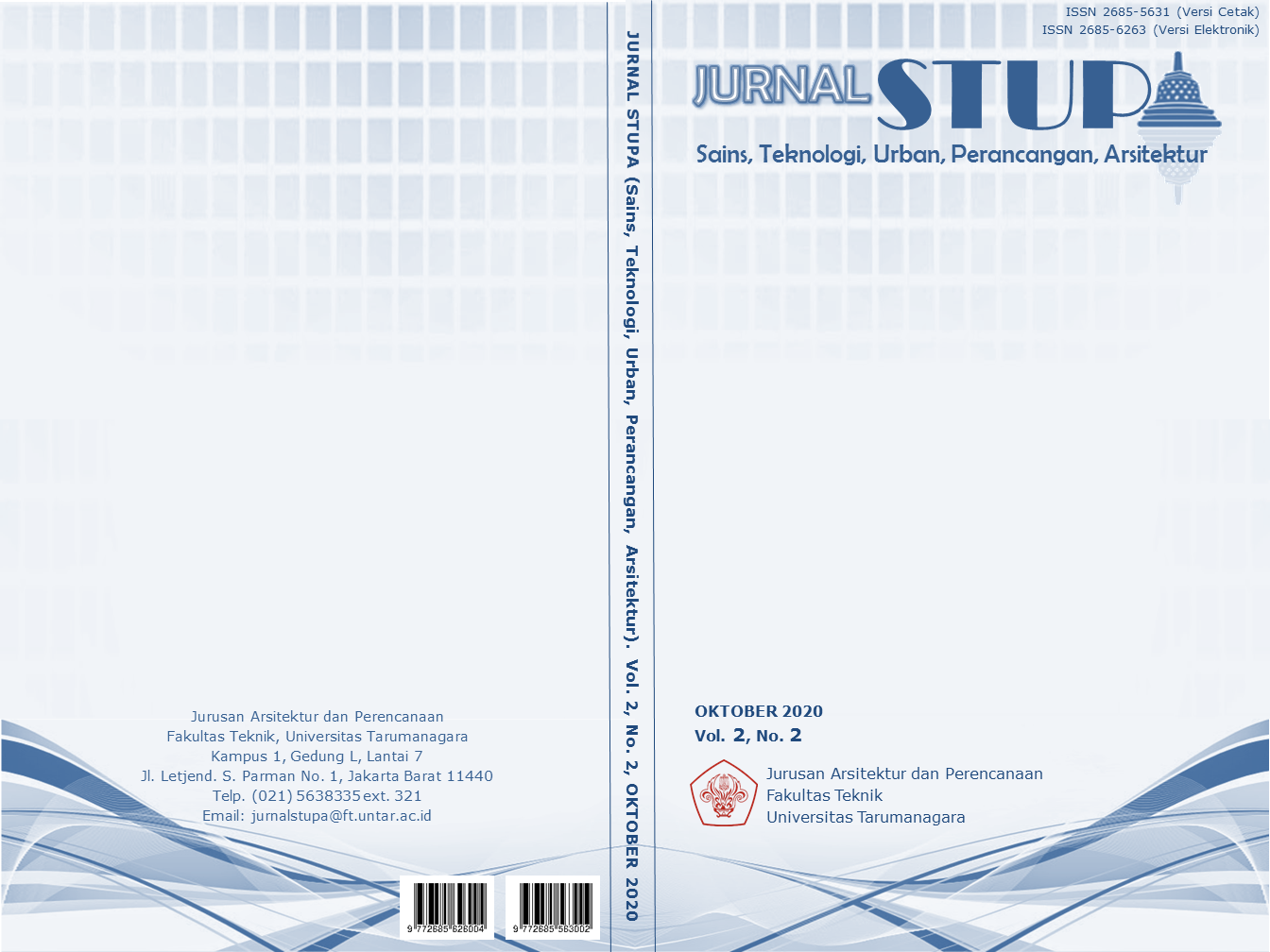EKSPLORASI RUANG EDUKASI KREATIF DALAM WUJUD THIRD PLACE DENGAN METODE KONTEKSTUAL DI KAWASAN HUNIAN PADAT MANGGARAI
Isi Artikel Utama
Abstrak
Excessive population growth and urbanization to the city are causing a dense residential area in the city of Jakarta. In this discussion, the area that is the center of attention is Manggarai, South Jakarta, seen from the number of dense residential that stands along the banks of the river and around the station. The problem of limited area in the residential causes terraces and the local road to be used as a place of interaction between citizens, which can cause disturbance to the area of residential privacy and resident movement. Garbage collection facilities in the area are also not well managed in terms of the number of garbage piles in residential areas. The study of the discussion is a recreational public building that can accommodate the interaction of dense residential communities. The purpose and benefits of this project are to create a form of space to interact and release stress between communities by responding to the issue of waste management in the form of Open Architecture and Third Place. Data methods were obtained from field observations, as well as literature studies on contextual architecture as a response to design in dense residential areas. The results of this study produced an architectural building with a program of a creative workshop from waste recycling that could accommodate community interactions in a creative way as well as waste management education for the community.
Keywords: contextual; creative; dense residential; education; recreation
Abstrak
Pertumbuhan penduduk dan urbanisasi ke pusat kota yang berlebih menyebabkan terjadinya area hunian padat di Kota Jakarta. Dalam pembahasan ini, wilayah yang menjadi perhatian adalah kawasan Kelurahan Manggarai, Jakarta Selatan, terlihat dari banyaknya hunian padat kumuh yang berdiri di sepanjang pinggiran sungai dan sekitar stasiun. Permasalahan keterbatasan lahan pada permukiman menyebabkan teras hunian serta jalan lalu lintas setempat dijadikan tempat berinteraksi antar warganya yang dapat menimbulkan gangguan terhadap area privasi hunian maupun lalu lintas pergerakan warga. Fasilitas penampungan sampah pada kawasan padat juga belum terkelola dengan baik ditinjau dari banyaknya titik penumpukan sampah pada kawasan hunian padat. Lingkup pembahasannya adalah mengenai bangunan publik rekreatif yang dapat menampung interaksi masyarakat hunian padat. Tujuan dan manfaat dari proyek ini, adalah menciptakan wujud ruang antara untuk berinteraksi dan melepas penat antar masyarakat dengan merespon isu manajemen sampah pada kawasan dalam wujud Open Architecture dan Third Place. Metode pengumpulan data diperoleh dari observasi lapangan, serta studi literatur mengenai arsitektur kontekstual sebagai respon perancangan desain pada kawasan hunian padat. Hasil dari penelitian ini sendiri menghasilkan suatu bangunan arsitektur dengan program fungsi lokakarya kreatif dari daur ulang sampah yang dapat menampung interaksi warga secara rekreatif sekaligus edukasi manajemen sampah bagi masyarakat.
Rincian Artikel
Referensi
Azwar, A. (1990). Pengantar Ilmu Lingkungan. Jakarta: Mutiara Sumber Widya.
Bovy, M. B. dan Lawson, F. (1977). Tourism and Recreation Development: A Handbook of Physical Planning. Boston: CBI Publishing Company
Brigham, J.C. (1991). Social Psychology. New York: Harpercollins Publisher.
Daniels, B. C. (1995). Puritans at Play Leisure and Recreation in Colonial New England. New York: St. Martin's Press.
Definisi Kontekstual. (2020). Diakses 15 Februari 2020, dari https://en.wikipedia.org/wiki/Contextual_architecture.
Definisi Lokakarya. (2020). Diakses 20 Juni 2020, dari https://kbbi.web.id/lokakarya
Definisi Pengelolaan Sampah. (2020). Diakses 20 Juni 2020, dari https://id.wikipedia.org/wiki/Pengelolaan_sampah
Definisi Recreation. (2020). Diakses 15 Februari 2020, dari https://en.wikipedia.org/wiki/Recreation
Definisi Rekreasi. (2020). Diakses 15 Februari 2020, dari https://id.wikipedia.org/wiki/Rekreasi
Definisi Sanggar. (2020). Diakses tanggal 20 Juni 2020, dari https://id.wikipedia.org/wiki/Sanggar
Definisi Sanggar. (2020). Diakses 20 Juni 2020, dari https://kbbi.web.id/sanggar
Definisi Third Place. (2020). Diakses 15 Februari 2020, dari https://en.wikipedia.org/wiki/Third_place
Heimstra, N.W. dan McFarling L.H. (1978). Enviromental Psychology 2nd Edition. California : Brooks / Cole Publishing Company.
Holahan, C. J. (1982). Environmental Psychology. New York: Random House.
Jormakka, K. (2008). Basics Design Methods. Berlin: Birkhauser Verlag AG.
Kodoatie, R. J. (2003). Manajemen dan Rekayasa Infrastruktur. Yogyakarta: Pustaka Pelajar.
Oldenburg, R. (1989). The Great Good Place. US: Da Capo Press.
Panduan Komplit Benda yang Bisa Didaur Ulang. Diakses 20 Juni 2020, dari https://waste4change.com/w4c-recyclables/2/
Pengertian Dari Unsur - Unsur Pembentuk Kota. Diakses 20 Juni 2020, dari https://scribd.com/document/339972170/Pengertian-Dari-Unsur
Penjelasan Konsep Hijau 3R. Diakses 20 Juni 2020, dari https://waste4change.com/waste4change-supports-3r-reduce-reuse-recycle-green-concept/2/
Sujarto, D. (1995). Perencanaan Kota Baru. Bandung: Penerbit ITB.



